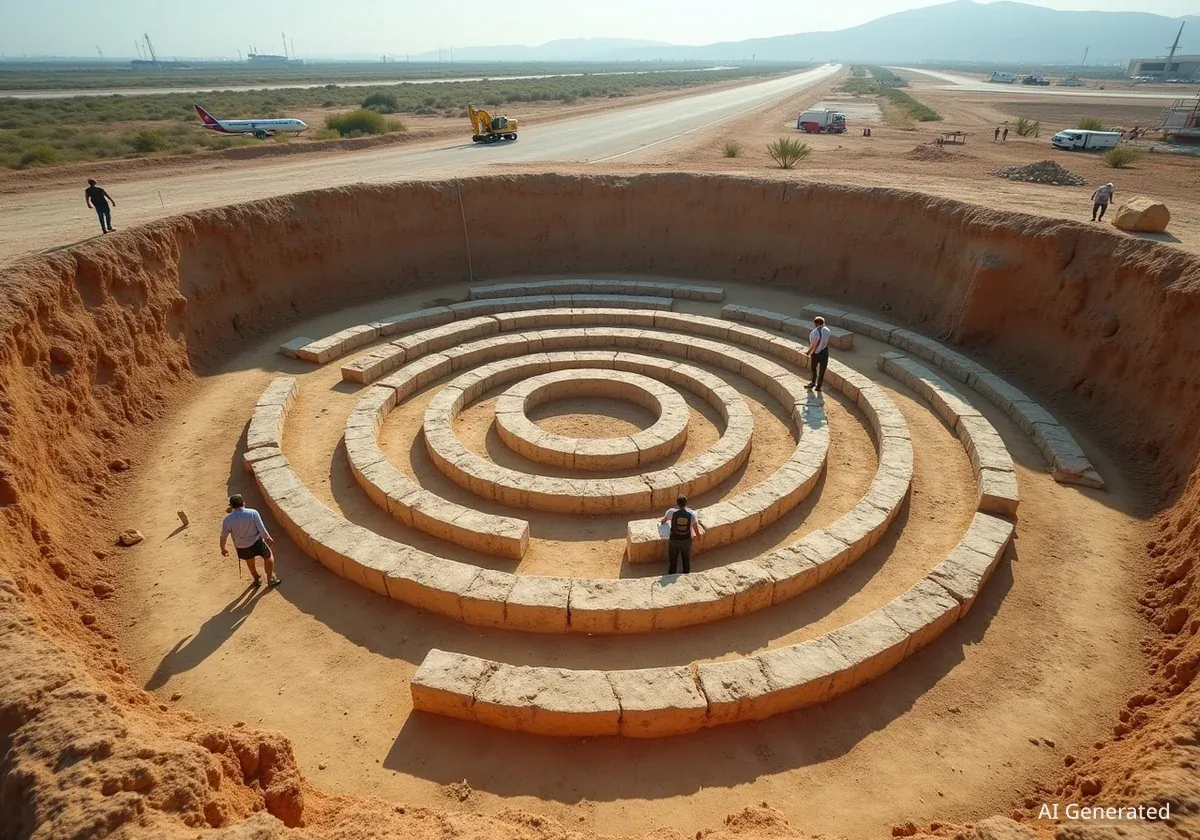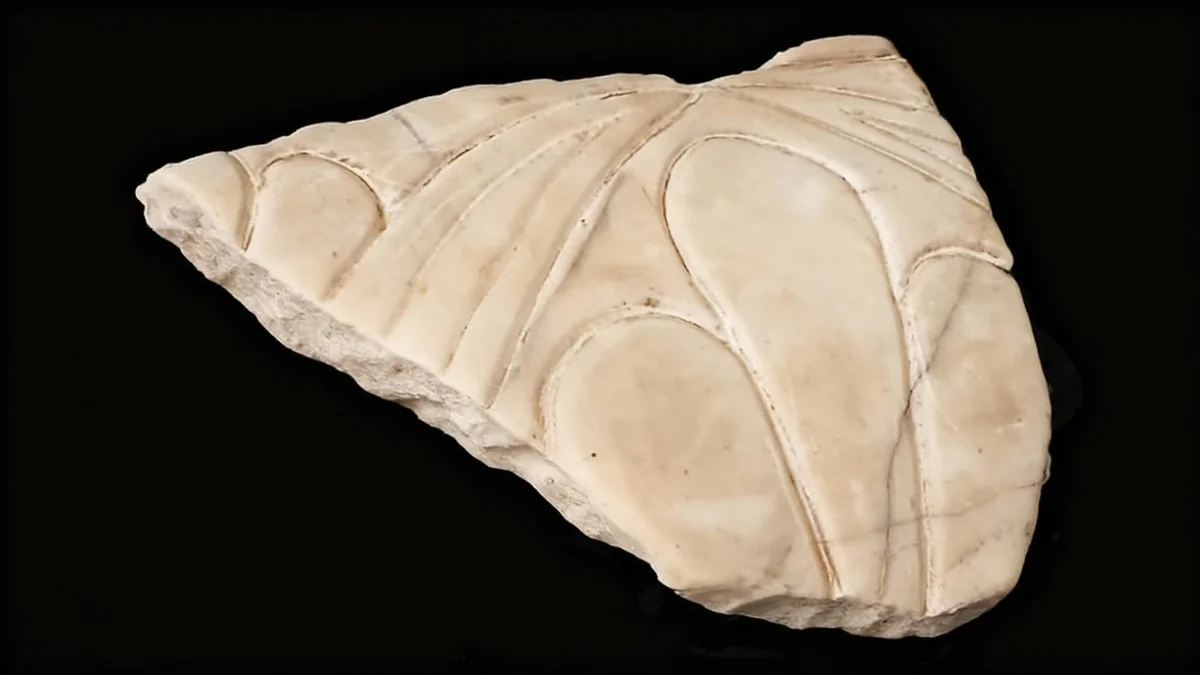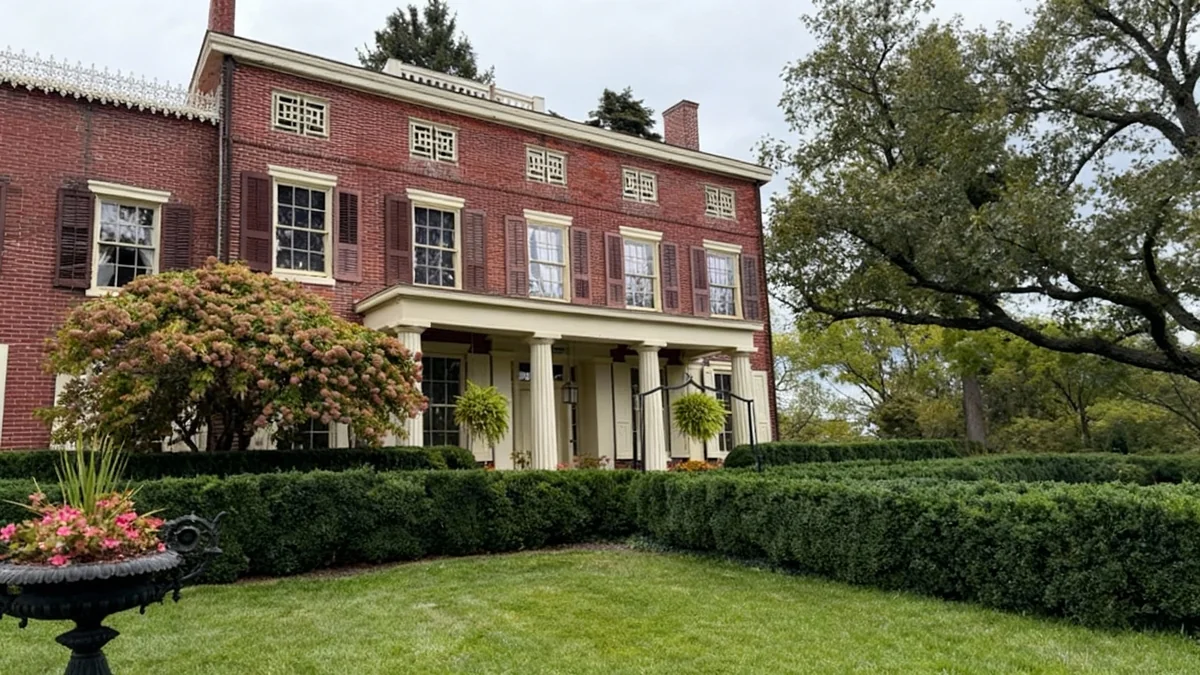Archaeologists on Crete have revealed preliminary findings of a monumental circular structure discovered on Papoura Hill. This unique Minoan labyrinth, uncovered in 2024, has no known parallel in prehistoric Crete or the wider Aegean region. Its discovery occurred during radar system installation for the new Heraklion airport.
The site represents a significant archaeological find, offering new insights into the early Minoan civilization. Experts are still working to understand its full purpose and meaning, but initial assessments suggest a complex ritualistic function rather than a permanent settlement.
Key Takeaways
- A large, circular Minoan structure was found on Papoura Hill, Crete.
- It has a diameter of 48-50 meters and a height of 2.85 meters.
- The building features seven overlapping stone rings in a labyrinthine design.
- Dating suggests construction between 3000–1700 BC, predating major Minoan palaces.
- Its purpose is believed to be for periodic, communal, and possibly ritualistic activities.
Discovery and Initial Impressions
The discovery of this monumental architectural complex took place during construction work for the new Heraklion airport. Workers were installing radar systems when they encountered the ancient remains. Danae Kontopodi, from the Heraklion Ephorate of Antiquities, described the structure as rare and impressive due to its size, age, and unique design. The excavation has been ongoing since the initial find in 2024.
Costas Paschalidis, President of the Association of Greek Archaeologists, has called the Papoura site one of the most important archaeological finds of the 21st century for the prehistoric Aegean region. This highlights the significance of the discovery for understanding ancient civilizations in Greece.
Structure Dimensions
- Diameter: 48-50 meters (approximately 157-164 feet)
- Preserved Height: 2.85 meters (approximately 9.35 feet)
- Covered Area: 1,800 square meters (approximately 19,375 square feet)
Architectural Design and Zones
The circular building features a complex design reminiscent of a labyrinth. It consists of seven overlapping stone-built rings, preserved at different elevations. These rings are organized into two main zones of occupation and use, designated as Zone A and Zone B, with an exterior Zone C.
Zone A: The Central Core
The center of the monument, Zone A, is a circular space. It is defined by two contiguous rings constructed using a corbelled vaulting technique. This technique creates an inner diameter of 9.30 meters, or about 30.5 feet. A large entrance on the west side provides access to this central area.
Inside Zone A, four walls are arranged in a cross shape. These walls form four rooms of similar size. The rooms connect through openings at the center of the cross. Archaeologists believe this central core was likely covered by a vaulted roof, adding to its monumental appearance.
Zone B: The Peripheral Ring
Surrounding the central core is Zone B. This area is made up of smaller rooms arranged radially. A circular paved corridor provided access to these rooms. In its initial phase, this corridor might have been an open outdoor space. Later, additional spaces were created within this corridor by adding partition walls of simpler construction.
The monument has two main entrances. These are located on the southwest and northeast sides. A conceptual straight line connecting these two entrances would pass directly through the center of the cruciform core in Zone A, indicating a deliberate and symmetrical design.
Zone C: The Exterior Base
The outermost area, Zone C, consists of tiered rings that form the base of the monument. This design resembles a crepis, which is a stepped platform, or a circular "ziggurat." An external polygonal enclosure further defines this outer zone, adding to the structure's overall complexity and grandeur.
Minoan Civilization Background
The Minoan civilization flourished on Crete and other Aegean islands during the Bronze Age, from roughly 2700 to 1450 BC. It is known for its advanced culture, elaborate palaces like Knossos, and unique art. The discovery at Papoura Hill dates to the Pre-palatial and Protopalatial periods, offering insights into Minoan society before the major palace complexes were built.
Construction Methods and Dating
The entire monument was constructed using unworked mountain stones. These stones were quarried from a specific site on the northwest slope of Papoura Hill. Mud, made from local clay-rich soil, served as the binding material. The construction demonstrates meticulous and sturdy craftsmanship.
The intricate design and robust construction suggest significant labor. It also points to specialized building experience, and possibly even mathematical or astronomical knowledge. This indicates a central administration likely organized and managed the entire project, highlighting a sophisticated level of societal organization.
"The structure's meticulous, sturdy, and intricate construction suggests significant labor, specialized experience, mathematical or even astronomical knowledge, and a central administration that organized the project," said a representative from the Greek Ministry of Culture.
Based on current data, the structure is tentatively dated between 3000–1700 BC. This period includes successive construction phases. Continuous maintenance, including repairs to walls, buttressing, and additions around the central dome over centuries, suggests the monument was a central focal point for the local inhabitants for a long time.
Purpose and Interpretation
The architectural layout, combined with the artifacts found, suggests this was not a simple, permanent residential settlement. Instead, archaeologists believe it was a site for periodic, community-wide, and likely ritualistic activities. The nature of these activities is still under investigation.
Initially, a large stone heap (lithosoros) on the summit was thought to be a phryktoria, a watchtower or beacon, part of a wider communication network. However, the current excavation has not yet provided definitive evidence to support this interpretation.
Artifacts Recovered
- Pottery: Found in all areas of Zone B and the four rooms of Zone A.
- Vessels: Mainly for food preparation and consumption, with fewer storage vessels.
- Lamps: Used for illumination.
- Miniature Vessels: A significant number, including small jugs and tumbler cups.
- Ceremonial Items: A unique bird-shaped vessel.
- Tools: Stone tools.
- Ornaments: Two pendant beads.
- Natural Objects: Marine shells, specifically tritons.
The types of finds, particularly the vessels for food and drink, support the idea of communal feasts or gatherings taking place at the site. The ceremonial bird-shaped vessel further emphasizes a ritualistic aspect.
Significance for Minoan Archaeology
The Papoura circular building is considered unique due to its complex architectural composition and its early dating. It demonstrates the technical and cultural sophistication of the emerging Minoan civilization. This development occurred long before the construction of the more famous and intricate Minoan palaces, such as Knossos.
Its construction during the Pre-palatial period might indicate the presence of powerful clans or local rulers. These leaders may have initiated such imposing monuments for reasons of social prestige or to foster community cohesion. These collective activities appear to have continued systematically throughout the entire Protopalatial period. The site's active use likely ended with the expansion of Knossos' power during the Neopalatial period.
Interestingly, the presence of Archaic-period pottery (7th–6th century B.C.) associated with feasting practices suggests that the ancestral collective memory of this site's importance may have persisted even into historical times. This indicates a long-lasting cultural significance.
The excavation is ongoing, and the conclusions may evolve as more data becomes available. However, the structure already stands as one of the most significant finds in Minoan archaeology. Its eventual interpretation is expected to reshape our understanding of the origins and organization of the Minoan civilization before the era of its great palaces.





